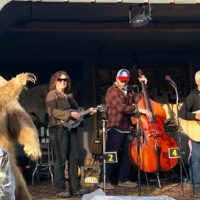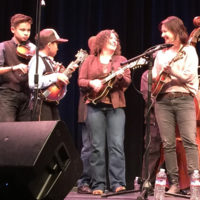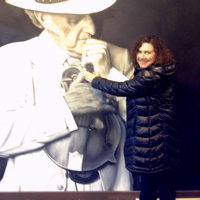
While looking for biographical info on Southern California mandolin player Nina Weisman, I ran across this from the Family Fiddle Camp, where she’s an instructor, and figured I could do no better than this.
“Nina Weisman is a fixture in the Central and Northern California bluegrass scene. She’s mentored many young mandolin players over the years and is a natural-born teacher. She’s won several regional picking contests and boasts a long list of performance credits with many California-based bluegrass bands. When not picking on her mandolin, you can find Nina sporting a ranger’s hat and leading a group or two around one of our beautiful National Parks.”
Hi Nina, how did you get hooked on bluegrass?
It took a while. My first exposures were homemade cassettes of friends’ favorite local bluegrass bands, and those never appealed to me. Then in 1994 I went to my first music festival, Strawberry, and Sam Bush was playing. I was completely blown away by him, and by the sound of the mandolin. Up until that point, I mostly listened to rock bands. I was always an avid music listener and really appreciated instrumental virtuosity. I’d never heard anything quite like his band. His set included a few bluegrass songs, and I started to pay attention when that word was mentioned. The whole music festival scene changed my life. I walked around the campsites and saw almost everyone with an instrument. Some of the campsites had jams as good as the main stage music!
By the next year, I decided to get either a mandolin or a banjo, since I loved the sound of both and wanted to be able to jam with my friends. The mandolin won since it was smaller and lighter and might fit in a backpack. I was working as a backcountry ranger at the time, and size and weight were very important. I started playing fiddle tunes of all genres, but as the years went by, I was more and more attracted to the energy and soul of traditional bluegrass. The more you study it, the more you realize how complex and interesting it is, and how difficult it is to play well. Now it’s by far my favorite type of music.
What instruments do you play?
My main instrument is the mandolin, but I play a little fiddle and piano. I won a Deering banjo at the CBA raffle last fall and I’ve been practicing rolls, so maybe I can add banjo to this list soon.
Do you remember your first instrument?
My first instrument as a kid was our 1800’s player piano (with the pedals) that I learned on. My first mandolin was a cheap Epiphone I used to see if I actually liked playing. I was looking for a better one a year or so after that.
Were you exposed to music when you were young?
My parents sent me to piano lessons when I was very young, and I continued them through high school. I also went to a private school where we studied a different instrument every year, so I learned some flute, recorder, guitar, and drums. After high school, I didn’t play anything until I picked up the mandolin in my 30s.
Who are your biggest influences?
Over the years, I’ve learned to appreciate multiple artists. At first, I was obsessed with Sam Bush, then got more into bluegrass and found Kenny Baker, Ronnie McCoury, Jesse McReynolds, Doyle Lawson, and finally Bill Monroe. Once I started listening to his live shows and started analyzing his playing, I realized how brilliant he was. Unfortunately, my early exposures to his playing were some of his lesser studio recordings, so it took me much too long to fully appreciate him. Now I realize it will take more than a lifetime to learn and absorb his contribution to music, so I’m stuck with him for a while.
I want to mention that the younger pickers in our bluegrass community are huge influences on me. I enjoy playing with them, and it motivates me to improve as much as possible so they’ll still want to play with me as they become monster pickers. It always amazes me how quickly younger people can learn and master their instruments compared to adults. I’ll never catch up, but it keeps me trying.
Do you write tunes?
I love writing tunes and have a few that I really like. The hard part is thinking up a name! I find songs much more difficult and haven’t managed writing any of those yet.
How do you learn a new song?
The first thing I do is listen to it over and over and over. Then I chart it out by figuring out all the chord changes, assigning them to measures, and writing it down. Then I listen to each measure over and over to make sure I have it exactly right and write it down. Then I listen again to make sure it’s exact. Then I play it to make sure I wrote it properly. And I use a pencil with a good eraser. In most cases, just this exercise cements the song in my head, and if it doesn’t, I have a good reference to refer to.
What bands have you played in?
My first band was called LilyWater in Ventura, California. It was all women, with three main singers and lots of instrumentalists. We played some bluegrass, folk, and Americana. I played fiddle for that band. Then I played in a four-piece band called Instant Grassification that had two mandolins. It was great!
I was in South County Special out of San Jose for a while. That was a really fun band and we played some of the California festivals. Currently I’m in a couple of bands in Alaska in the summers, where I work as a seasonal ranger in Denali. One is called Northern River and is led by Carl Hoffman. He’s known as the Alaskan father of bluegrass. Many of the great pickers up there have been in his band. Bill Monroe once asked Carl to join his band, but he had a family and couldn’t afford the cut in pay. We play traditional bluegrass and get booked at many of the summer festivals up there.
I also play in Ginger Boatwright’s band. She was a leading member of Red, White and Blue (Grass), and was in Doug Dillard’s band for many years. She has the best stories of my bluegrass idols since she lived in Nashville and knew all of them! In her band we play many of her original songs and some traditional bluegrass.
What keeps you busy these days?
I’ve been quite busy. I work at my county library, and even though we’re closed, there’s plenty of work to do. We work in separate rooms and wear masks, and we wash our hands often! I also work part-time for the court system as an investigator, and I’ve been spending time in the garden and practicing. Soon I’ll be heading north to Alaska for the summer. The main change for me has been the cancellation of all the festivals and jams.
What interests you when you’re not playing music?
I love to travel, both in the wilderness and elsewhere. Since I bought my house I don’t travel internationally as much as I used to, but I do get around North America a bit. I also love to garden.
Do you have any students?
Currently I don’t have any regular students, although I occasionally give lessons at festivals. I teach beginning mandolin regularly at the Julian Family Fiddle Camp in April. I also do workshops on jamming etiquette and Monroe-style mandolin playing.
What jamming faux pas do you see most often and how might a jam leader address them?
The worst mistakes I’ve noticed are when people don’t listen or look around them. The most important thing is to pay attention to what everyone else is doing, which includes listening to the volume, paying attention to the timing, and just overall being aware of what everyone is doing. It takes a lot of years of experience and practice to be able to hear everything that’s going on, and adjust accordingly but that needs to happen to have a good jamming experience. When I’m trying to get people to be aware of this, I will sometimes suggest that everybody try to hear the guitar solo, or listen to the bass so that they stay in time, or some other comment directed towards improving the sound, but not picking on any one person. It’s especially good to remind less experienced people to listen to everything that’s going on.
What are the best qualities of a teacher?
The best qualities a teacher can have are being able to understand the various ways people learn, and then being able to explain things in a way that suits the student’s learning method.
What shows, events, or venues are most memorable for you?
Strawberry Music Festival will always be memorable for turning me onto bluegrass and the mandolin, and all the great friends and experiences there. I haven’t gone for years now though. The CBA Father’s Day Festival at Grass Valley, of course, is epic. Wintergrass is always a favorite. Pickers converge there from Canada and all over the Northwest; it’s a good opportunity to meet new people and make new friends.
You’re a champion of the Monroe style. What grabs you about his playing?
The more I studied Monroe’s playing, the more I realized how much emotion and dynamics he used. He varied rhythms and patterns, emphasized phrases, and really spoke with his mandolin playing. I also love the definitive nature of his solos. He wasn’t wimpy about it – he played it like he meant it. He also favored melody in most cases. All of these things resonate with me and my personality and my way of thinking about music, so I started studying. And I will be studying for a long time!
Are there any particular eras of Monroe that are your favorite?
I don’t know that I have a favorite. His first version of Tennessee Blues is awesome, and Southern Flavor, written near the end of his career, is one of his best. Can’t say anything uncomplimentary about anything in between.
Can you share some tips?
Practice as much as you can. LISTEN. Listen to the recordings over and over, listen to other players, listen to recordings you make of yourself playing.
What are some musical challenges you’ve had?
Learning to improvise has been exceedingly difficult for me. I originally learned music by reading musical notation. At first I used a lot of notation and tab to learn the mandolin, and still do sometimes. It’s hard for me to vary something when I know how it was originally written. There’s the melody. When I hear a song, the melody is stuck in my head. I’ve had to really struggle to learn ways to vary the melody enough to sound like I’m improvising! I have many friends who struggle to play something the same way twice. It’s just how our different brains work.
What do you do when you first pick up your instrument?
First I tune it. Then I’ll usually work on a picking exercise. I like to play one of the classical ones, and I’ll use a metronome. I’ll play it first with all downstrokes, then again with all upstrokes, then finally with both down and upstrokes. This has helped clean up my picking and also realigns my pick grip.
Why do you feel music touches people so deeply?
Sounds have been part of human existence, and people have always created music around them. Maybe it started with imitating nature, but it sure has evolved. Then there’s the human voice. It’s how we communicate thoughts, feelings, and ideas. Humans have always expressed themselves with sounds and voices. I think it’s hardwired into our beings, and when done well it really affects us.
What other artists and styles do you listen to?
When I decided I liked bluegrass and wanted to play it, I figured I’d better immerse myself in order to learn faster. So I mostly listen to bluegrass, the more traditional the better. I also like to listen to old-time/contra dance music. I appreciate music with a strong danceable beat but done on stringed instruments.
What type of mandolin do you play?
I play a late-’80s Gibson F5L made by Charlie Derrington. He’s the luthier who repaired Bill Monroe’s shattered mandolin. It was a good mandolin when I bought it about 15 years ago, and it’s matured into a great mandolin. After some research, I think Charlie was trying to re-create the original Gibson Fern when he made mine.
How do the Southern and Northern California bluegrass scenes differ?
I lived in Ventura County when I started playing mandolin and spent a lot of time at SoCal events. There were many people to play with, and I enjoyed meeting other musicians and making lifelong friends. There are some jams spread throughout SoCal, but there weren’t any near me, so I helped start the Ventura jam, which is still going! I think that, at the time, most pickers were happy playing multiple genres of music, and it was hard for me to find much traditional bluegrass. As I got more obsessed, I found hard-core traditionalists in the Northern California scene. That really satisfied my cravings for hard-driving bluegrass. In the time since, I think there’s been a resurgence of traditional bluegrass in SoCal, and I’m so happy to hear about that! I’ve learned that regions are influenced by the pickers that have lived there and will be quite different just a few hours apart! It’s fascinating.
Any final thoughts for the readers?
Hi everyone. Hang in there during the ‘Time of COVID’ and wear your masks and wash your hands! I’m looking forward to seeing all of you at the next event we can have safely!
Thanks, Nina, for sharing your California Bluegrass story.
Thank you, Dave, for including me your list of amazing musicians you have interviewed!!!
_______________________________________________________
Since Nina mentioned Sam Bush at Strawberry, I thought people might enjoy this full set his band played at the final Strawberry Music Festival at Camp Mather near Yosemite before fires made the site untenable for festivals – at least for now. Sam was a fixture at this festival and many others throughout the West.










